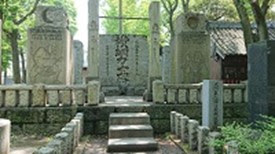Keiko Miyoshi
I had two
memories.
One of
those was a story in medieval period: One Samurai had rain on his way back from his father's
home. He didn’t have a raincoat,蓑(みの),so he
stopped at a farmers house and asked to borrow it. A woman came out from the
house and gave him a small branch of Japanese yellow rose(山吹の花). Then, she sang
him Waka, Classic Japanese poem,「七重、八重、花は咲けども山吹の実の(みの)1つだに無きぞ悲しき」. The samurai didn’t
understand its meaning, so his subordinate taught him the meaning. “She would
like to lend you a raincoat, but she is poor, what she can do is only give a branch
of Japanese yellow rose”. The samurai was ashamed of his lack of knowledge.
Then he started to learn Classic Japanese poem.
I read this
story in my young age. Back then, I was impressed by her action and poem, “what
a elegant lady she was!". But, I was not interested in the Samurai at all.
Another
memory was a samurai stature.
Before The
Tokyo Metropolitan Government office was moved to Sinjuku, the offices were
located near to JR,Yurakucho station. City workers had opportunity to go there with
documents in urgent time. I saw one samurai stature that was standing in front
of the first building of the Government office. “Who is he ? ”. Again, I had no
interest in that Samurai.
A lot
of water has flowed under the bridges.
Recently,
I had chance to learn Koto-ku history through some books. Onagigawa river was constructed
to transport salt from Gyotoku in Chiba prefecture, to Edo, now Tokyo. It was
first work by Tokugawa Ieyasu(徳川家康), first governor in Edo period (※1603~1867). He is an
icon who built Edo Castle and continued 260 years peaceful era.
But, in
the moment, I found one samurai name in a small space in the book. His name is
Ota Dokan(太田道灌) who built
Edo Castle in the latter period of Muromachi period (※1336~1549). Original main castle and 2 another buildings of Edo Castle were built by him. Furthermore,
small ports were constructed near the castle and the economy was flourishing.
He was a clever person with the pen and sword. He had loyalty to his master and
expanded their territory. Unfortunately, he was assassinated by a plot because
allied armies feared his ability. He was also good at literature, “A story of the
Japanese yellow rose ” was introduced in the same page in the book.
At that moment, two memories were connected in
my mind. The samurai, who was given a Japanese yellow rose, and the stature of
Samurai, was Ota Dokan. Then I thought "Where did the stature go?"
I opened
my PC, and found that it has been setting in the Glass Building of the Tokyo Forum,
former site of the Tokyo Government office. Surprisingly, I also found a lot of
his statures in Kanto area. I know Tokugawa Ieyasu is a prominent person. But
I believe Ota Dokan was also honored by many people. Otherwise there aren’t so
many statures.
I found a feeling of satisfaction and relief in
my mind.
※depens on data
























